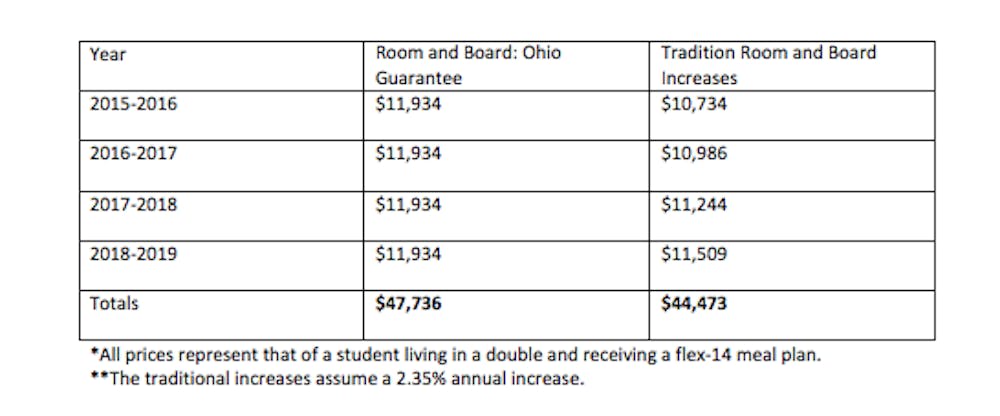One student analyzes the numbers behind Ohio University’s new locked-in tuition rate.
Over the summer, the Ohio state government mandated a two-year tuition freeze that will stop any increases in tuition at state universities for the next two academic years. Similarly, Ohio University is offering all incoming freshmen the OHIO Guarantee, which allows a locked-in tuition rate for each student’s first (and hopefully only) four years on campus. However, the OHIO Guarantee also costs more than normal tuition would had it increased at previous rates. Supposedly, the line of thinking is that over the course of four years, the locked-in tuition will end up being cheaper than four years of tuition hikes would be. However, when breaking down the numbers, this does not appear to be the case.
{{tncms-asset app="editorial" id="0e76269a-73c4-11e5-ac97-0b61c610aa36"}}
The OHIO Guarantee promises a locked-in tuition rate of $11,548 a year for the next four years, bringing the total amount spent on tuition, over the course of four years, to $46,192. In the five years before the OHIO Guarantee, (the 2010-11 school year through the 2014-15 school year), tuition had been rising at an average of 2.53 percent annually. Also, because of the budget passed this summer, tuition could not be raised for the next two school years anyway. Using these facts, it can be estimated that tuition would only cost $42,949 for four years without the Ohio Guarantee, a savings of $3,243.
{{tncms-asset app="editorial" id="2a7a69e6-73c4-11e5-ba09-4390c913fcd4"}}
Also, it is important to note that in 2010, OU had a four-year graduation rate of only 45 percent, meaning that a significant number of students (55 percent minus transfers and dropouts) will be subject to an even higher tuition rate once they come back for their additional semesters on campus.
The OHIO Guarantee also proves to make room and board more expensive as well. Much like it does for tuition, the OHIO Guarantee ensures that meal plans and on-campus housing remain the same price over a four-year period. For instance, if a student were to hypothetically live in the two-person dorm room and purchase a flex 14 meal plan for all four years he or she is on campus, it would cost him or her $11,934 a year, or $47,436 for all four years. Between the 2010-11 and 2014-15 academic years, room and board had been increasing at an average annual rate of 2.48 percent. Using this number, the four-year cost of room and board, not using the OHIO Guarantee, would be $44,473.
Accounting for the differences in tuition and room and board, the OHIO Guarantee estimates the four-year cost of attending college $6,506 more expensive than it would have been (using traditional price increases). To put this in perspective, that is more than half as much as the cost of one semester under the OHIO Guarantee. Looking at it another way, say that 4,500 students enrolled as freshmen this year. In a perfect world, where every single one of these students graduated in four years, the university would be making $29,277,000 more than they would not using the OHIO Guarantee. In conclusion, though the OHIO Guarantee seems like a student-friendly plan on the surface, in reality it proves to be even more costly than the traditional tuition hikes of the past.
Max Pristic is a research assistant at the Center for College Affordability and Productivity.






